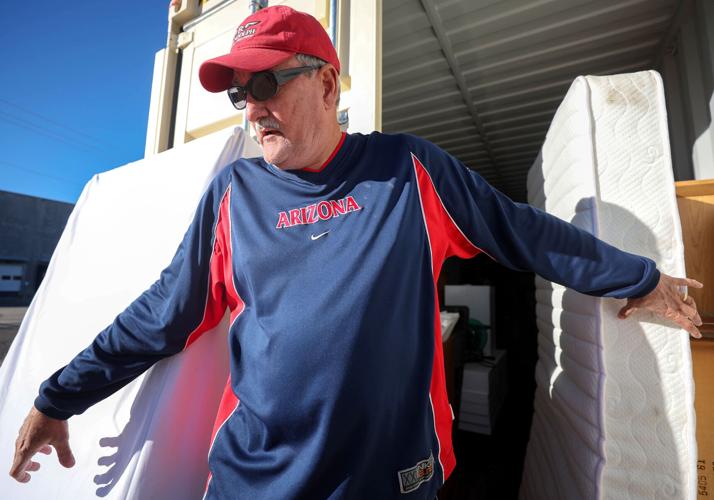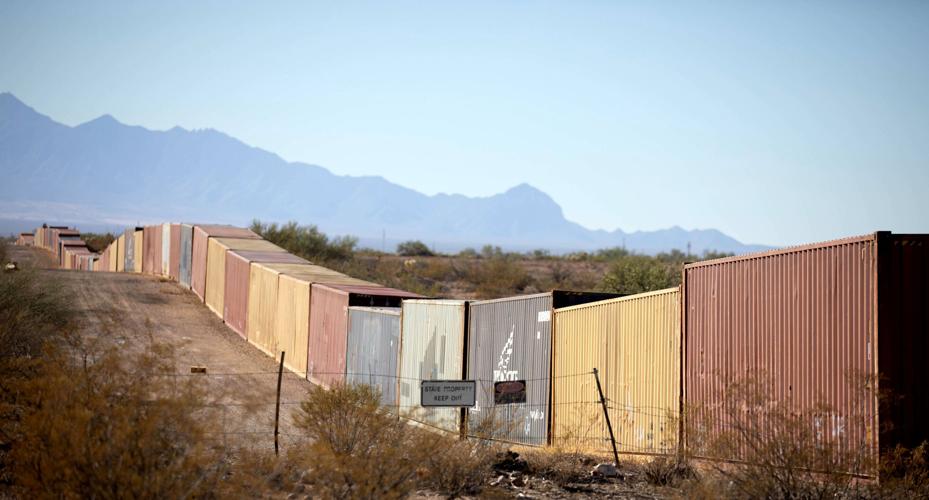The idea came up even before the container wall on Arizona’s border with Mexico came down.
“Let’s turn the containers into housing.”
You could hear it among protesters who helped stop the construction of the wall in Cochise County, and among others who contemplated the thousands of empty shells stacked along the rural border, belong to the state. In those banged-up hulks, these visionaries saw a remedy for homelessness and Arizona’s shocking cost of housing.
Containers, have after all, been a growing trend in housing and commercial projects for more than a decade, including in Tucson. And it would be a good way to turn former Gov. Doug Ducey’s $175 million boondoggle into something positive.
It made so much sense that in February Gov. Katie Hobbs touted the idea, while visiting a new homeless shelter built of containers — these containers sourced in Long Beach.
“We are working on a plan to get those (border) containers to nonprofits in cities that want to use them for affordable housing,” Hobbs said.
Nine months later, that vision is slow to materialize. Only one entity, a Tucson nonprofit, has bought a couple of former border-wall containers with the plan to turn them into housing.
Others have been sold to municipalities for storage, and about 1,900 of the original 2,200 remain for sale, parceled out for auction in batches every two weeks. Most of them are stored alongside the Arizona State Prison Complex on South Wilmot Road.
They are being offered at a relatively low price, a $2,000 starting bid, probably significantly cheaper than what the state bought them through the contractor who built the container walls.
When that company, called AshBritt, bought them, containers were in short supply and expensive, said Brian Stark, founder and CEO of Steel + Spark, a company that makes container housing in Phoenix. He estimated the cost in 2021 at $5,000 to $6,000 each.
Now they are cheap, and even the state’s $2,000 price is not bringing out many bidders at the online auction where they’re sold. Last week, none of the ten 40-foot containers for sale by the state Department of Administration had any higher bids.
“For us, the price isn’t good enough,” Stark told me. “What we’re buying at the port (of Long Beach) now is cheaper than what the state is selling them for. It’s easier to go through the typical supply chain that we use.”
So far, that dream of turning the border-wall boondoggle into a cheap-home boom is languishing on the desert outside the state prison.

Border wall shipping containers sit in place at the Arizona State Prison Complex, E. Old Vail Connection Rd., on Wednesday.
Eight-unit project
There’s one exception: The project that Bryan Benz and his nonprofit, Wholistic Transformations, is putting together behind Bethel Community Baptist Church at 446 S. Plumer Ave. In a dirt lot along East 15th Street that was donated by the church, Benz and others are working to build an 8-unit housing project for foster children who have turned 18.
They’re using containers.
In fact, on Nov. 8, Benz took delivery of two small containers from the state’s border-wall stash, which he bought for just $500 each. They’re 20-feet long, while almost all of the state’s containers are 40 feet. The group plans to join those two small containers side by side into a nearly square home.
These two were classified as “D” class, or the worst the state offered.
“We were very pleasantly surprised by the D quality,” Benz said. “I only bought two because I really didn’t have any confidence that they were usable. I was able to risk the money to see they are usable.”
They also bought a “one-trip” container, one that has only been used for one trip across the ocean, elsewhere. That one is so clean that they are planning to insulate the outside and leave the metal as interior walls.
The vision is to have a cluster of homes for young adults in the 18-21 age range, an age when young people can remain in the foster-care system but often don’t, and end up in problems. They risk becoming pregnant, homeless or landing in prison, Benz said.
It’s not the only cluster of homes like this for former foster kids being built in Tucson. I Am You 360, another local charity, is building 10 tiny homes for youths transitioning out of the foster system near South Craycroft Road and East 22nd Street, but they are not container homes.
Benz said his group decided to use containers because they are the cheapest option. They anticipate about $40,000 per 320-square-foot unit, with the labor for construction donated. The total cost he anticipates being around $450,000.
Each house will have a queen-size bed, a full bathroom, a galley kitchen and sofa — everything a small home needs.
Once complete, he said, “The house is going to look like a mud adobe house — Southwest style, very attractive.”
Another housing idea
Benz hasn’t been the only local housing advocate eyeing the containers. Beau Phillips, who protested against the border wall, founded a group called Boxes of Hope, which intends to turn the containers into housing for homeless people. The project is not off the ground yet, but Phillips said he’s making progress.
For his part, Benz isn’t sure yet where his group is going to get the few other containers they need. Might be from the state, might not. The state’s containers need more work but are much cheaper than the one-trip containers.
His first experience with the state wasn’t that encouraging. Benz called it a “bureaucratic nightmare” in which his application to buy as a nonprofit languished for months due to missing paperwork that no one told him about.
“When the wall was built and then taken down, the hope was that the state would donate the shipping containers to us,” he said.
That, to me, makes sense, if we really want nonprofits and local governments to make housing out of the containers, as the governor said she wanted.
Make them cheap, even make them free. It would make it that much cheaper to build low-end homes, which are never going to be very profitable.
And that’s better than them sitting out by a prison in the desert, aggravating the boondoggle that the container-wall already represents.
The Homing Project is working to build a village of tiny homes in Tucson. This pop-up house is one of 15 planned in the first village and can be seen at the Tucson Mall starting Jan. 13. Video by Pascal Albright / Arizona Daily Star






